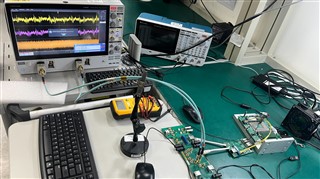零件編號: DP83TG720EVM-MC
工具/軟體:
嗨,TI 團隊,
我們已經使用 TekExpress 成功設定了 SPE 測試環境,現在我們可以執行測試模式 1~7,如所附螢幕截圖 test environment.jpg 所示。
我們希望您能就模式 1 和模式 4 的一些失敗結果和問題提供協助。以下是我們的客製化專案板 (X303-EC) 和 CRB 參考板之間的比較:
模式 1 → 無波形輸出,無法進行測試。 CRB 也會出現此問題。
模式 2 → X303-EC 測試結果為失敗;CRB 測試結果為通過。然而,誤差幅度僅 ~0.02。
模式 4 → 無法測試。根據軟體 SOP,此測試需要特殊夾具。 CRB 也存在同樣的問題。
模式 5 → 結果失敗,與 CRB 相同。
模式 6 → 通過,結果與 CRB 相同。
我們將非常感謝您就以下事項提供指導:
-
模式 1 和模式 4 是否有任何已知問題或其他要求?
-
您能否確認在每種測試模式下波形擷取的正確偵測位置(例如,TRD_P/N或其他) ?
Test_Mode_1
begin
000D 0001
000E 0904
000D 4001
000E 2000
end
Test_Mode_2
begin
000D 0001
000E 0904
000D 4001
000E 4000
end
Test_Mode_4
begin
000D 0001
000E 0904
000D 4001
000E 8000
000D 001F
000E 0453
000D 401F
000E 0019
end
Test_Mode_5
begin
000D 0001
000E 0904
000D 4001
000E A000
end
Test_Mode_6
begin
000D 0001
000E 0904
000D 4001
000E C000
end



